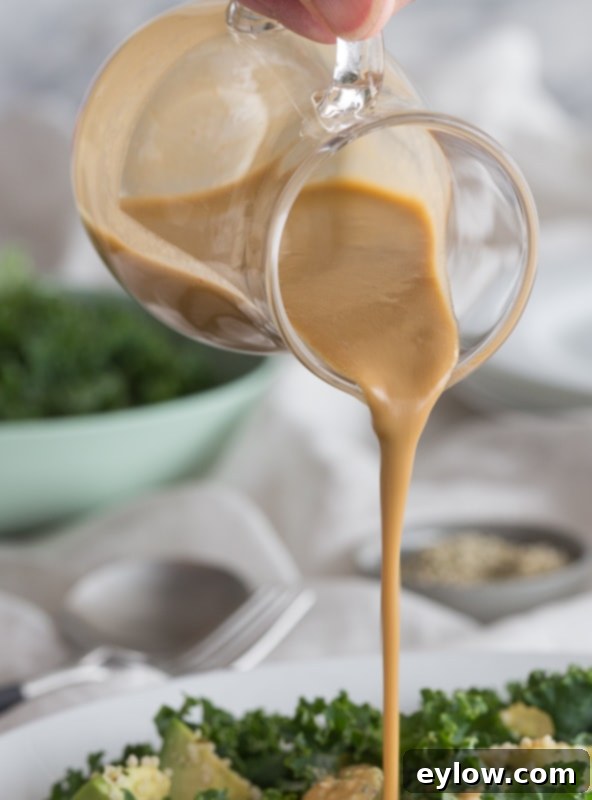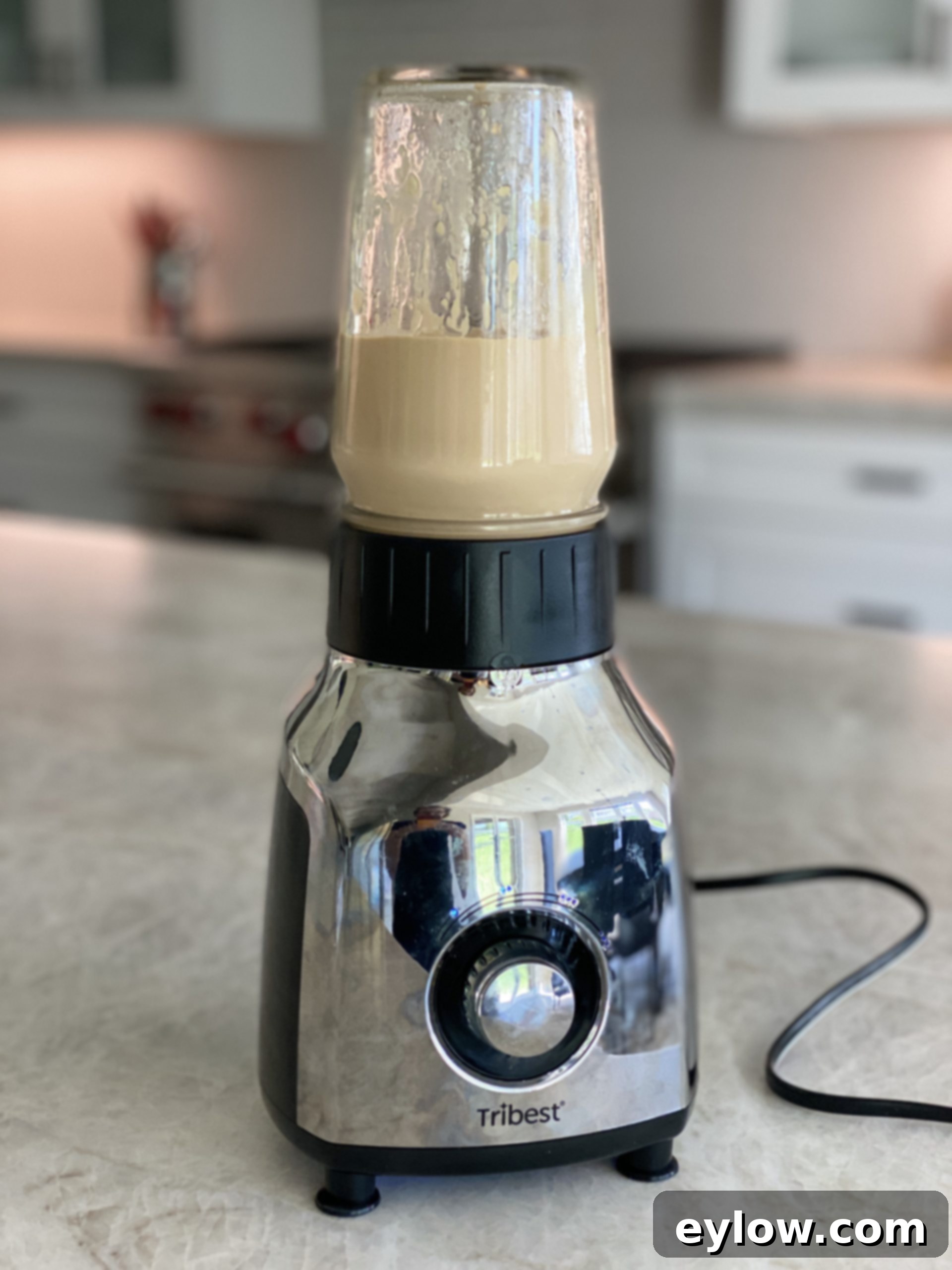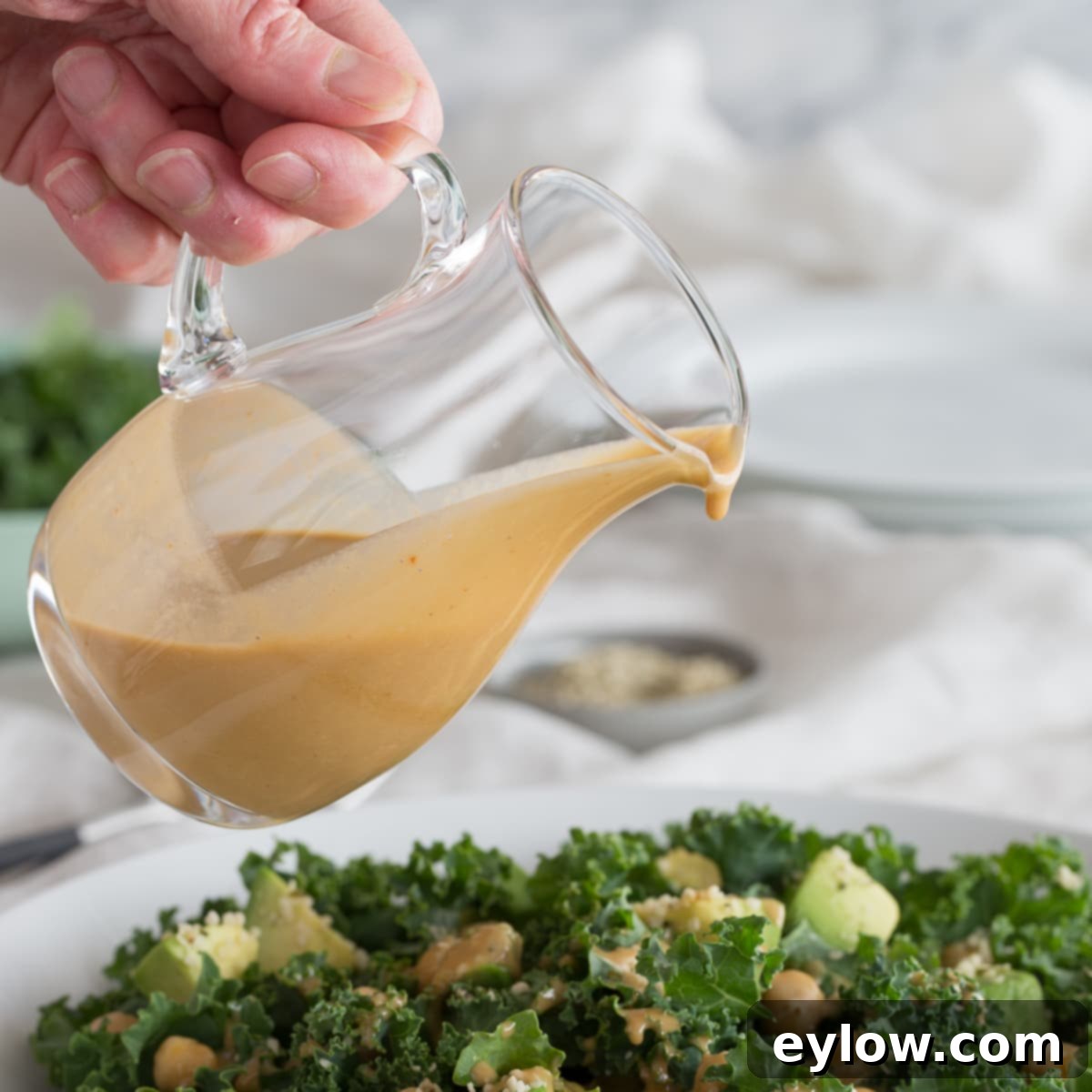Mastering Creamy Lemon Tahini Dressing: Your Guide to a Versatile, Healthy & Flavorful Kitchen Staple
For those robust salad greens like hearty kale, crisp romaine, or even tender spinach, a dressing that truly adheres to each leaf is essential. This is precisely why a rich, creamy tahini dressing is the perfect choice. Its velvety texture and complex flavor beautifully coat and complement sturdier greens, elevating a simple salad into a culinary experience. This particular creamy tahini dressing recipe has been crafted not just for salads, but for a multitude of culinary applications, making it an indispensable part of your kitchen repertoire. Prepare a batch on Sunday, and you’re halfway to effortlessly creating quick, delicious, and healthy meals throughout your busy week. Beyond salads, this versatile dressing transforms into an exquisite tahini sauce for grilled fish, roasted chicken, succulent shrimp, or even as a vibrant dip for fresh vegetables.

The Allure of Creamy Lemon Tahini Dressing
Originally formulated to perfectly dress a vibrant curly kale and avocado salad, this creamy lemon tahini dressing quickly proved its incredible adaptability, shining equally bright on various other salads. Its rich, nutty profile balanced with bright citrus also makes it an exceptional tahini sauce for a variety of proteins and vegetables, providing a welcome change from more common dressings like a simple French Vinaigrette. Its unique appeal and versatility were so evident that it truly deserved its own dedicated spotlight, ensuring it wouldn’t be overlooked as merely an accompaniment to a single salad recipe. This dressing offers a delightful blend of earthy tahini and zesty lemon, creating a flavor that is both comforting and refreshing.
What is Tahini? Unlocking the Power of Sesame
Tahini, a fundamental ingredient in many Middle Eastern and Mediterranean cuisines, is essentially a paste made from ground sesame seeds. Think of it as a butter, similar to how almonds are transformed into almond butter, but with a distinctly earthy, nutty, and slightly savory flavor profile unique to sesame. While many might recognize tahini primarily as a key component in homemade hummus, its culinary potential extends far beyond, making it an excellent base for flavorful dressings, sauces, and dips. The type of tahini greatly influences the final taste and texture of your dressing. I personally find that raw, untoasted tahini offers a milder, less bitter flavor, which is often preferable for dressings where you want the other ingredients to shine through without being overpowered. As a natural product, tahini can sometimes separate in the jar, with the oil rising to the top. This is completely normal and easily remedied; simply use a sturdy table knife or a spoon to vigorously stir the oil back into the paste until it’s smooth and well-combined. This ensures a consistent texture and flavor throughout your batch. Tahini is also a nutritional powerhouse, rich in healthy fats, protein, essential minerals like calcium, magnesium, and iron, and B vitamins, contributing to the overall health benefits of your meals.
Why Choose a Creamy Tahini Dressing?
Beyond its delectable taste, creamy tahini dressing offers numerous advantages that make it a superior choice for health-conscious food lovers and culinary adventurers alike:
- Naturally Dairy-Free Creaminess: Tahini’s natural oils and finely ground texture create a luxuriously creamy emulsion without the need for any dairy products. This makes it an ideal option for those with lactose intolerance, dairy allergies, or anyone following a vegan or plant-based diet.
- Rich Nutritional Profile: As mentioned, tahini is packed with nutrients. When incorporated into a dressing, it adds healthy monounsaturated and polyunsaturated fats, fiber, and protein to your meal, enhancing satiety and providing sustained energy.
- Unique Flavor Depth: The earthy, slightly bitter notes of tahini, when brightened with lemon and other seasonings, create a complex flavor profile that is both intriguing and satisfying. It’s a taste that stands out and adds an exotic touch to everyday dishes.
- Exceptional Emulsification: Tahini acts as a natural emulsifier, helping to bind oil and water-based ingredients together seamlessly. This results in a stable, smooth dressing that won’t easily separate, providing a consistent texture with every bite.
- Gut-Friendly Benefits: Sesame seeds are a good source of fiber, which is beneficial for digestive health. Incorporating tahini into your diet can contribute to a healthy gut microbiome.
Versatility Beyond the Salad Bowl: A Multi-Purpose Sauce
The true magic of this creamy lemon tahini dressing lies in its incredible versatility. It’s not just a salad dressing; it’s a multi-purpose sauce that can elevate countless dishes. Here are just a few ways to utilize its delicious potential:
- For Salads: Perfect for coating heartier greens like kale, romaine, and cabbage, but also fantastic on mixed greens, grain bowls, and even warm roasted vegetable salads.
- As a Marinade: Its creamy texture and bold flavor make it an excellent marinade for chicken, fish, tofu, or vegetables before grilling, baking, or roasting. It helps tenderize and infuse a rich taste.
- Dipping Sauce: Serve it alongside crunchy raw vegetables (carrots, cucumbers, bell peppers), warm pita bread, falafel, or even as a dip for sweet potato fries. Its thick consistency makes it perfect for scooping.
- Sauce for Bowls and Wraps: Drizzle generously over Buddha bowls, grain bowls, wraps, or sandwiches for an added layer of moisture and flavor. It can replace mayonnaise or other heavier sauces.
- With Roasted Vegetables: A simple drizzle over roasted broccoli, cauliflower, carrots, or asparagus after cooking can transform them into a gourmet side dish.
- On Grilled Meats and Seafood: Spoon it over grilled salmon, pan-seared chicken breasts, or skewers of lamb for a burst of fresh, nutty flavor.
Tahini Dressing Ingredient Tips & Smart Substitutes
Crafting the perfect creamy tahini dressing starts with quality ingredients and a few smart techniques. Here’s a closer look at the components and how to get the best results, along with useful substitutions:
- Extra Virgin Olive Oil: Use a good quality extra virgin olive oil for the best flavor. It forms the rich base of the dressing and contributes to its silky texture.
- Fresh Lemon Juice: Always opt for fresh lemon juice. The bright, zesty notes of fresh lemon are crucial for balancing the richness of the tahini and adding a vibrant tang. Bottled lemon juice often lacks the same depth and freshness.
- Tahini: As discussed, I prefer raw, untoasted tahini for a milder flavor. Remember to stir well if the oil has separated. A good quality tahini will be smooth and pourable, not gritty or overly thick.
- Garlic: To ensure the garlic blends in smoothly and its flavor is fully integrated without harsh chunks, chop the cloves as finely as possible. Then, using the flat side of your knife (or a garlic press), smear it into a smooth paste. This technique releases more of its aromatic compounds and creates a harmonious flavor.
- Tamari or Soy Sauce: These add a vital umami depth to the dressing. For a gluten-free option, tamari is excellent. If you need a vegan or soy-free alternative, coconut aminos are a fantastic substitute, offering a similar savory flavor profile.
- Ketchup: This might seem like an unusual ingredient for a tahini dressing, but a touch of ketchup provides a subtle sweetness, a hint of tomato umami, and a lovely reddish hue that enhances the dressing’s overall appeal. If you don’t have ketchup, a little tomato paste mixed with a tiny bit of water can be used as a substitute.
- Unseasoned Rice Vinegar or White/Champagne Vinegar: Vinegar adds another layer of acidity and complexity. Unseasoned rice vinegar is mild and delicate, perfect if you prefer a less sharp dressing. White vinegar offers a more pronounced tang, while champagne vinegar provides a slightly floral and fruity note. Choose based on your preference or what you have on hand.
- Balsamic Vinegar: A small amount of balsamic vinegar introduces a rich, slightly sweet, and tangy depth that complements the other flavors beautifully. It adds a gourmet touch to the dressing.

Making Your Creamy Tahini Dressing: Shake or Blend
Preparing this dressing is incredibly simple, requiring minimal effort and just a few minutes of your time. You have two main methods:
- The Shake Method: The easiest way to make this dressing is to place all the ingredients into a jar with a tight-fitting lid. Ensure the lid is securely closed, then shake vigorously for 1-2 minutes until all ingredients are thoroughly combined and the dressing achieves a smooth, creamy consistency. This method works perfectly for a quick preparation and provides a slightly thicker, rustic texture.
- The Blender Method: For an exceptionally smooth and silky dressing, a blender is your best friend. Add all ingredients to a small blender or personal blender. Blend on low speed, gradually increasing if needed, until the dressing is completely homogenous and creamy. This method is particularly effective for ensuring the garlic is perfectly incorporated and the tahini is fully emulsified. A great tool for making dressings, sauces, and smoothies is the Tribest Personal Glass Blender, known for its efficiency and ease of cleaning.
Adjusting Consistency: Tahini can vary in thickness, so you might find your dressing is too thick. If it’s not pourable enough for your liking, simply thin it out by adding a tiny bit of cold water, one teaspoon at a time, until you reach your desired consistency. Blend or shake again after each addition. Always taste and adjust seasonings as needed, adding a pinch more salt, a dash of pepper, or an extra squeeze of lemon juice to suit your palate.

Storage and Meal Prep Perfection
Once prepared, this creamy lemon tahini dressing stores beautifully, making it an excellent candidate for meal preppers. Transfer the dressing to an airtight container or a jar with a tight lid and store it in the refrigerator. It will keep well for up to a week. The flavors may even meld and deepen slightly over time. If the dressing thickens in the fridge, simply let it sit at room temperature for a few minutes or add a tiny splash of water and shake or stir well before serving to restore its original consistency. Having a batch of this dressing ready means you can quickly assemble nutritious salads, elevate simple roasted vegetables, or add a burst of flavor to your protein-packed meals throughout the week without any last-minute fuss.

A Note on Food Allergies and Sensitivities
For individuals with peanut allergies, tahini can be an excellent and flavorful replacement for peanut butter, offering a similar creamy texture and nutty profile in many recipes. However, it is crucial to understand that while sesame seeds are not botanically classified as tree nuts, they are a common allergen. Some individuals with tree nut allergies may also experience allergic reactions to sesame seeds due to cross-reactivity between certain proteins. Symptoms of a sesame allergy can range from mild (hives, itching) to severe (anaphylaxis). Therefore, if you have any food allergies, especially to nuts, it is paramount to exercise caution. Always consult with an allergist or healthcare professional to determine if sesame is safe for your consumption. For more detailed information on sesame allergies and how to manage them, Healthline provides a comprehensive article that can offer further guidance and understanding.
Histamine-Friendly Adjustments for Sensitive Individuals
For those managing histamine sensitivities or following a low-histamine diet, slight modifications can make this delicious dressing more suitable. The primary adjustments involve skipping the 2 teaspoons of ketchup and swapping the tamari (or soy sauce) for coconut aminos. Ketchup often contains fermented ingredients and tomatoes, both of which can be higher in histamines for some individuals. Similarly, soy products like tamari are fermented and may not be tolerated by everyone with histamine sensitivities. Coconut aminos provide a wonderful umami flavor without the soy or potential histamine concerns. If your histamine management is well-controlled, these small amounts might not pose an issue for you, but it’s always best to listen to your body and adjust accordingly. Many individuals, including myself, find this dressing enjoyable even with minor histamine concerns because the amounts of potentially problematic ingredients are small, and the overall profile is so appealing.
📖 Recipe

Creamy Lemon Tahini Dressing
Sally Cameron
Pin Recipe
Ingredients
- 6 tablespoons extra virgin olive oil
- 2 tablespoons lemon juice
- 2 tablespoons tahini (sesame seed paste)
- 1 large garlic clove finely chopped
- 2 teaspoons low sodium tamari or soy sauce sub coconut aminos
- 2 teaspoons ketchup
- 2 teaspoons unseasoned rice or white vinegar
- 2 teaspoons Balsamic vinegar
Instructions
-
Place all ingredients in a jar with a tight fitting lid and shake well until creamy. Alternatively use a blender on low speed and puree until creamy. If dressing is too thick thin with a little water.
